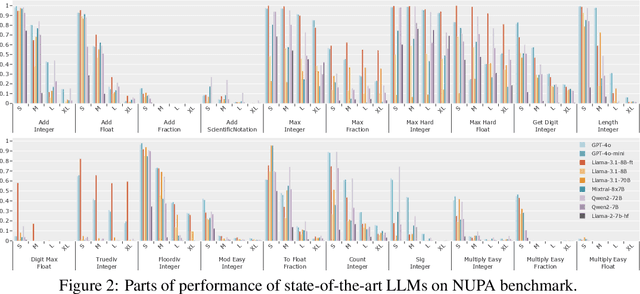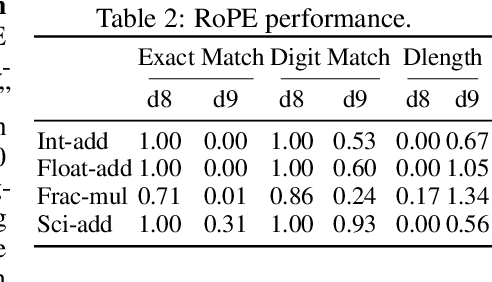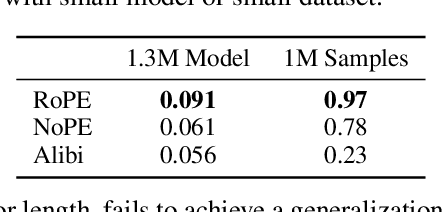Haotong Yang
VACT: A Video Automatic Causal Testing System and a Benchmark
Mar 08, 2025Abstract:With the rapid advancement of text-conditioned Video Generation Models (VGMs), the quality of generated videos has significantly improved, bringing these models closer to functioning as ``*world simulators*'' and making real-world-level video generation more accessible and cost-effective. However, the generated videos often contain factual inaccuracies and lack understanding of fundamental physical laws. While some previous studies have highlighted this issue in limited domains through manual analysis, a comprehensive solution has not yet been established, primarily due to the absence of a generalized, automated approach for modeling and assessing the causal reasoning of these models across diverse scenarios. To address this gap, we propose VACT: an **automated** framework for modeling, evaluating, and measuring the causal understanding of VGMs in real-world scenarios. By combining causal analysis techniques with a carefully designed large language model assistant, our system can assess the causal behavior of models in various contexts without human annotation, which offers strong generalization and scalability. Additionally, we introduce multi-level causal evaluation metrics to provide a detailed analysis of the causal performance of VGMs. As a demonstration, we use our framework to benchmark several prevailing VGMs, offering insight into their causal reasoning capabilities. Our work lays the foundation for systematically addressing the causal understanding deficiencies in VGMs and contributes to advancing their reliability and real-world applicability.
LIFT: Improving Long Context Understanding of Large Language Models through Long Input Fine-Tuning
Feb 20, 2025Abstract:Long context understanding remains challenging for large language models due to their limited context windows. This paper presents Long Input Fine-Tuning (LIFT), a novel framework for long-context modeling that can improve the long-context performance of arbitrary (short-context) LLMs by dynamically adapting model parameters based on the long input. Importantly, LIFT, rather than endlessly extending the context window size to accommodate increasingly longer inputs in context, chooses to store and absorb the long input in parameter. By fine-tuning the long input into model parameters, LIFT allows short-context LLMs to answer questions even when the required information is not provided in the context during inference. Furthermore, to enhance LIFT performance while maintaining the original in-context learning (ICL) capabilities, we introduce Gated Memory, a specialized attention adapter that automatically balances long input memorization and ICL. We provide a comprehensive analysis of the strengths and limitations of LIFT on long context understanding, offering valuable directions for future research.
Training Large Language Models to be Better Rule Followers
Feb 17, 2025Abstract:Large language models (LLMs) have shown impressive performance across a wide range of tasks. However, they often exhibit unexpected failures in seemingly straightforward tasks, suggesting a reliance on case-based reasoning rather than rule-based reasoning. While the vast training corpus of LLMs contains numerous textual "rules", current training methods fail to leverage these rules effectively. Crucially, the relationships between these "rules" and their corresponding "instances" are not explicitly modeled. As a result, while LLMs can often recall rules with ease, they fail to apply these rules strictly and consistently in relevant reasoning scenarios. In this paper, we investigate the rule-following capabilities of LLMs and propose Meta Rule-Following Fine-Tuning (Meta-RFFT) to enhance the cross-task transferability of rule-following abilities. We first construct a dataset of 88 tasks requiring following rules, encompassing diverse reasoning domains. We demonstrate through extensive experiments that models trained on large-scale rule-following tasks are better rule followers, outperforming the baselines in both downstream fine-tuning and few-shot prompting scenarios. This highlights the cross-task transferability of models with the aid of Meta-RFFT. Furthermore, we examine the influence of factors such as dataset size, rule formulation, and in-context learning.
GL-Fusion: Rethinking the Combination of Graph Neural Network and Large Language model
Dec 08, 2024



Abstract:Recent research on integrating Large Language Models (LLMs) with Graph Neural Networks (GNNs) typically follows two approaches: LLM-centered models, which convert graph data into tokens for LLM processing, and GNN-centered models, which use LLMs to encode text features into node and edge representations for GNN input. LLM-centered models often struggle to capture graph structures effectively, while GNN-centered models compress variable-length textual data into fixed-size vectors, limiting their ability to understand complex semantics. Additionally, GNN-centered approaches require converting tasks into a uniform, manually-designed format, restricting them to classification tasks and preventing language output. To address these limitations, we introduce a new architecture that deeply integrates GNN with LLM, featuring three key innovations: (1) Structure-Aware Transformers, which incorporate GNN's message-passing capabilities directly into LLM's transformer layers, allowing simultaneous processing of textual and structural information and generating outputs from both GNN and LLM; (2) Graph-Text Cross-Attention, which processes full, uncompressed text from graph nodes and edges, ensuring complete semantic integration; and (3) GNN-LLM Twin Predictor, enabling LLM's flexible autoregressive generation alongside GNN's scalable one-pass prediction. GL-Fusion achieves outstand performance on various tasks. Notably, it achieves state-of-the-art performance on OGBN-Arxiv and OGBG-Code2.
Number Cookbook: Number Understanding of Language Models and How to Improve It
Nov 06, 2024



Abstract:Large language models (LLMs) can solve an increasing number of complex reasoning tasks while making surprising mistakes in basic numerical understanding and processing (such as 9.11 > 9.9). The latter ability is essential for tackling complex arithmetic and mathematical problems and serves as a foundation for most reasoning tasks, but previous work paid little attention to it or only discussed several restricted tasks (like integer addition). In this paper, we comprehensively investigate the numerical understanding and processing ability (NUPA) of LLMs. Firstly, we introduce a benchmark covering four common numerical representations and 17 distinct numerical tasks in four major categories, resulting in 41 meaningful combinations in total. These tasks are derived from primary and secondary education curricula, encompassing nearly all everyday numerical understanding and processing scenarios, and the rules of these tasks are very simple and clear. Through the benchmark, we find that current LLMs fail frequently in many of the tasks. To study the problem, we train small models with existing and potential techniques for enhancing NUPA (such as special tokenizers, PEs, and number formats), comprehensively evaluating their effectiveness using our testbed. We also finetune practical-scale LLMs on our proposed NUPA tasks and find that 1) naive finetuning can improve NUPA a lot on many but not all tasks, and 2) surprisingly, techniques designed to enhance NUPA prove ineffective for finetuning pretrained models. We further explore the impact of chain-of-thought techniques on NUPA. Our work takes a preliminary step towards understanding and improving NUPA of LLMs. Our benchmark and code are released at https://github.com/GraphPKU/number_cookbook.
Case-Based or Rule-Based: How Do Transformers Do the Math?
Feb 27, 2024Abstract:Despite the impressive performance in a variety of complex tasks, modern large language models (LLMs) still have trouble dealing with some math problems that are simple and intuitive for humans, such as addition. While we can easily learn basic rules of addition and apply them to new problems of any length, LLMs struggle to do the same. Instead, they may rely on similar "cases" seen in the training corpus for help. We define these two different reasoning mechanisms as "rule-based reasoning" and "case-based reasoning". Since rule-based reasoning is essential for acquiring the systematic generalization ability, we aim to explore exactly whether transformers use rule-based or case-based reasoning for math problems. Through carefully designed intervention experiments on five math tasks, we confirm that transformers are performing case-based reasoning, no matter whether scratchpad is used, which aligns with the previous observations that transformers use subgraph matching/shortcut learning to reason. To mitigate such problems, we propose a Rule-Following Fine-Tuning (RFFT) technique to teach transformers to perform rule-based reasoning. Specifically, we provide explicit rules in the input and then instruct transformers to recite and follow the rules step by step. Through RFFT, we successfully enable LLMs fine-tuned on 1-5 digit addition to generalize to up to 12-digit addition with over 95% accuracy, which is over 40% higher than scratchpad. The significant improvement demonstrates that teaching LLMs to explicitly use rules helps them learn rule-based reasoning and generalize better in length.
Chain of Images for Intuitively Reasoning
Nov 09, 2023Abstract:The human brain is naturally equipped to comprehend and interpret visual information rapidly. When confronted with complex problems or concepts, we use flowcharts, sketches, and diagrams to aid our thought process. Leveraging this inherent ability can significantly enhance logical reasoning. However, current Large Language Models (LLMs) do not utilize such visual intuition to help their thinking. Even the most advanced version language models (e.g., GPT-4V and LLaVA) merely align images into textual space, which means their reasoning processes remain purely verbal. To mitigate such limitations, we present a Chain of Images (CoI) approach, which can convert complex language reasoning problems to simple pattern recognition by generating a series of images as intermediate representations. Furthermore, we have developed a CoI evaluation dataset encompassing 15 distinct domains where images can intuitively aid problem-solving. Based on this dataset, we aim to construct a benchmark to assess the capability of future multimodal large-scale models to leverage images for reasoning. In supporting our CoI reasoning, we introduce a symbolic multimodal large language model (SyMLLM) that generates images strictly based on language instructions and accepts both text and image as input. Experiments on Geometry, Chess and Common Sense tasks sourced from the CoI evaluation dataset show that CoI improves performance significantly over the pure-language Chain of Thoughts (CoT) baselines. The code is available at https://github.com/GraphPKU/CoI.
Explaining the Complex Task Reasoning of Large Language Models with Template-Content Structure
Oct 09, 2023Abstract:The continuous evolution of pre-trained large language models with ever-growing parameters and corpus sizes has augmented their capacity to solve complex tasks. This ability, which obviates the necessity for task-specific training or fine-tuning, relies on providing the model with a language description or some task exemplars -- referred to the prompt -- that guide the desired autoregressive generation. Despite the remarkable success, the underlying mechanisms that facilitate such exceptional generalization abilities remain an open question. In this paper, we present a novel framework that formally conceptualizes answer generation for complex natural language tasks as a hierarchical ``template-content'' structure. According to our modeling, there exist pre-trained models that can automatically decompose tasks into constituent steps during autoregressive generation, through language modeling on a sufficiently large corpus, thereby solving them. Our framework offers an explanatory tool for the complex reasoning abilities of large language models from the perspective of modeling autoregressive generation tasks. Our experiments show that practical models exhibit different behaviors for ``template'' and ``content'' providing support for our modeling.
Code Prompting: a Neural Symbolic Method for Complex Reasoning in Large Language Models
May 29, 2023Abstract:Large language models (LLMs) have scaled up to unlock a wide range of complex reasoning tasks with the aid of various prompting methods. However, current prompting methods generate natural language intermediate steps to help reasoning, which can cause imperfect task reduction and confusion. To mitigate such limitations, we explore code prompting, a neural symbolic prompting method with both zero-shot and few-shot versions which triggers code as intermediate steps. We conduct experiments on 7 widely-used benchmarks involving symbolic reasoning and arithmetic reasoning. Code prompting generally outperforms chain-of-thought (CoT) prompting. To further understand the performance and limitations of code prompting, we perform extensive ablation studies and error analyses, and identify several exclusive advantages of using symbolic promptings compared to natural language. We also consider the ensemble of code prompting and CoT prompting to combine the strengths of both. Finally, we show through experiments how code annotations and their locations affect code prompting.
Neural Common Neighbor with Completion for Link Prediction
Feb 02, 2023Abstract:Despite its outstanding performance in various graph tasks, vanilla Message Passing Neural Network (MPNN) usually fails in link prediction tasks, as it only uses representations of two individual target nodes and ignores the pairwise relation between them. To capture the pairwise relations, some models add manual features to the input graph and use the output of MPNN to produce pairwise representations. In contrast, others directly use manual features as pairwise representations. Though this simplification avoids applying a GNN to each link individually and thus improves scalability, these models still have much room for performance improvement due to the hand-crafted and unlearnable pairwise features. To upgrade performance while maintaining scalability, we propose Neural Common Neighbor (NCN), which uses learnable pairwise representations. To further boost NCN, we study the unobserved link problem. The incompleteness of the graph is ubiquitous and leads to distribution shifts between the training and test set, loss of common neighbor information, and performance degradation of models. Therefore, we propose two intervention methods: common neighbor completion and target link removal. Combining the two methods with NCN, we propose Neural Common Neighbor with Completion (NCNC). NCN and NCNC outperform recent strong baselines by large margins. NCNC achieves state-of-the-art performance in link prediction tasks.
 Add to Chrome
Add to Chrome Add to Firefox
Add to Firefox Add to Edge
Add to Edge